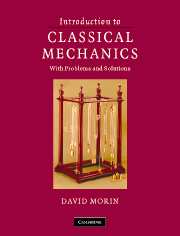Book contents
- Frontmatter
- Contents
- Preface
- 1 Strategies for solving problems
- 2 Statics
- 3 Using F = ma
- 4 Oscillations
- 5 Conservation of energy and momentum
- 6 The Lagrangian method
- 7 Central forces
- 8 Angular momentum, Part I (Constant L^)
- 9 Angular momentum, Part II (General L^)
- 10 Accelerating frames of reference
- 11 Relativity (Kinematics)
- 12 Relativity (Dynamics)
- 13 4-vectors
- 14 General Relativity
- Appendix A Useful formulas
- Appendix B Multivariable, vector calculus
- Appendix C F = ma vs. F = dp/dt
- Appendix D Existence of principal axes
- Appendix E Diagonalizing matrices
- Appendix F Qualitative relativity questions
- Appendix G Derivations of the Lv/c2 result
- Appendix H Resolutions to the twin paradox
- Appendix I Lorentz transformations
- Appendix J Physical constants and data
- References
- Index
11 - Relativity (Kinematics)
- Frontmatter
- Contents
- Preface
- 1 Strategies for solving problems
- 2 Statics
- 3 Using F = ma
- 4 Oscillations
- 5 Conservation of energy and momentum
- 6 The Lagrangian method
- 7 Central forces
- 8 Angular momentum, Part I (Constant L^)
- 9 Angular momentum, Part II (General L^)
- 10 Accelerating frames of reference
- 11 Relativity (Kinematics)
- 12 Relativity (Dynamics)
- 13 4-vectors
- 14 General Relativity
- Appendix A Useful formulas
- Appendix B Multivariable, vector calculus
- Appendix C F = ma vs. F = dp/dt
- Appendix D Existence of principal axes
- Appendix E Diagonalizing matrices
- Appendix F Qualitative relativity questions
- Appendix G Derivations of the Lv/c2 result
- Appendix H Resolutions to the twin paradox
- Appendix I Lorentz transformations
- Appendix J Physical constants and data
- References
- Index
Summary
We now come to Einstein's theory of relativity. This is where we find out that everything we've done so far in this book has been wrong. Well, perhaps “incomplete” would be a better word. The important point to realize is that Newtonian physics is a limiting case of the more correct relativistic theory. Newtonian physics works perfectly fine when the speeds we're dealing with are much less than the speed of light, which is about 3 · 108 m/s. It would be silly, to put it mildly, to use relativity to solve a problem involving the length of a baseball trajectory. But in problems involving large speeds, or in problems where a high degree of accuracy is required, we must use the relativistic theory. This is the subject of the remainder of this book.
The theory of relativity is certainly one of the most exciting and talked-about topics in physics. It is well known for its “paradoxes,” which are quite conducive to discussion. There is, however, nothing at all paradoxical about it. The theory is logically and experimentally sound, and the whole subject is actually quite straightforward, provided that you proceed calmly and keep a firm hold of your wits.
- Type
- Chapter
- Information
- Introduction to Classical MechanicsWith Problems and Solutions, pp. 501 - 583Publisher: Cambridge University PressPrint publication year: 2008



